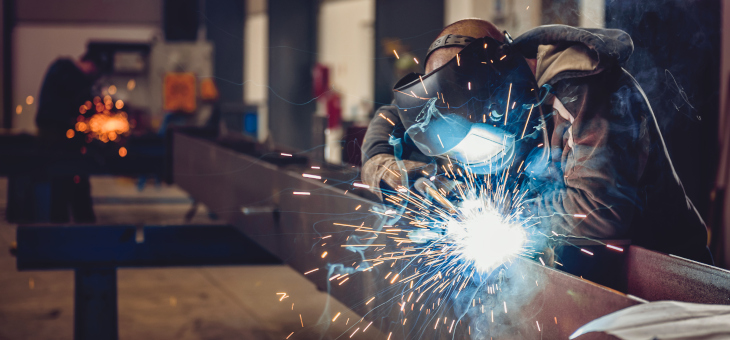Steel sector : Very low prices hitting company margins

The steel industry worldwide
China is the biggest producer and consumer of steel. Its domination has been increasing over time, and it is currently responsible for 45% of global production (in terms of value) and 49% of global consumption. The Chinese steel sector is still struggling with the scourge of overcapacity, leading to overcapacity worldwide. The European Union is in second place with 17% of global production (in terms of value). Japan is the closest follower at 12%. Then come India (7%) and the USA (5%). China’s share of global production is expected to increase over time on the back of growing production while that of other countries is expected to decline (mainly due to lower production), except in India. Therefore, China is comfortably settled in its leadership seat.
Globally, 56% of the world’s steel consumption is dedicated to building, infrastructure and transport, 15% to mechanical equipment and 12% to automotive sector, with other metal products (11%), domestic appliances and electrical equipment (both 3%) accounting for the rest, according to the World Steel Association. Steel prices are therefore dictated by the demand from those sectors. Still, the current slowdown affecting the global economy is the most severe since the crisis of 2009. Global industrial production is slowing down very rapidly and global trade has reached a post-crisis low. And to stir up trouble, the ongoing trade war between China and the USA is an additional cause for concern for international trade. Indeed, the bursts of tariffs that they both apply represent an extra burden for importing firms, increasing their costs, reducing economic activity and, ultimately, reducing the demand for metal (including steel). Besides, the European manufacturing sector is facing uncertainties and a marked slowdown, as shown by the various European countries’ Purchase Manager Index (PMI) contractions. Finally, a sword of Damocles still hangs over the European car industry, which is a big consumer of steel: the White House has not yet decided whether it will apply tariffs on imports of European cars into the USA. Although the easiest way for them was through the application of Section 232, this option is no longer possible because the deadline was 13 November 2019. If Mr Trump still wants to put tariffs on imports of European automobiles, he will have to find another way. We cannot say that the danger is definitely averted, but it has been removed for the time being, bringing relief, but still leaving uncertainty.
Given the ongoing global economic slowdown, global overcapacity and continuing trade tensions, we expect the steel price to decline further, as it has been doing since August 2018 (see graph 1). Looking ahead, one of the main risks for the steel industry is a larger than currently expected downturn in economic activity.

From the point of view of inputs, iron ore and coking coal are the raw materials most intensively used in steel production, representing about 60% of producers’ costs in the USA and China. Since a Vale dam collapsed in Brazil at the beginning of 2019 – combined with other incidents reducing the production of iron ore in Australia – the price of iron ore has skyrocketed. It increased by 65% between mid-January and mid-July 2019, impacting producers’ margins, and has since decreased (see graph 2). We expect the price of iron ore to stabilise at around CNY 85/MT which is relatively high (the YTD average is CNY 91/MT while the 2017-2018 average is CNY 68/MT), and decrease further in 2020. Steel producers with integrated iron ore production should not be affected as much by the price increase. Iron ore production is expected to increase in Brazil, leading to lower iron ore prices both in Brazil and globally, as the country is a big iron ore exporter.

Most of the producers (except Japan and the Eurozone) do not seem to have been impacted by the raw material cost increase, since the margins have remained stable or increased. The margins in China are weak but should improve in the coming years. In the year ahead, Indian steel producers are expected to benefit from strong local demand for steel, hence their margins are likely to increase. In contrast, in the Eurozone the demand from the machinery and automotive sectors is weak, which is likely to weigh on margins. Moreover, there is no regional giant in the Eurozone that can compete with foreign steel-making firms. Other problems for the European steel-making industry are that they have higher energy and raw material costs than their foreign competitors and they face stricter environmental regulations, which put them under additional pressure, while European policies to protect the local steel industry from inflows (mainly from China and Turkey) do not seem effective1.
Conclusion
To sum up we can say that the global steel sector is in trouble. The economic slowdown, trade uncertainty, the trade war between China and the United States and global overcapacity in the steel sector are the main reasons for the three-year low affecting steel prices. Europe appears to be the worst affected, because of its exposure to international trade, weak internal demand and production costs. Given the sharp drop in prices, the competition will be all the harder between the different players in the sector. The survival and/or geographical presence of some companies is in jeopardy. We can expect payment difficulties and further consolidation, mainly in South East Asia and, if allowed, in the European Union.
Analyst: Matthieu Depreter – m.depreter@credendo.com
1 In September 2019, total steel imports by European countries were 128% higher than the record low in 2009, according to Bloomberg